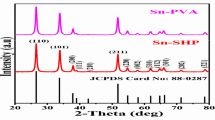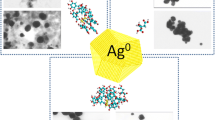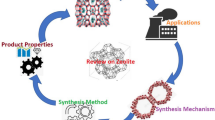Abstract
TiO2 nanoparticles with different shapes and sizes were synthesised by the sol-gel route in Water/Brij78/Hexane reverse microemulsions. The aqueous cores of these microemulsions were used as nanoreactors to control sol-gel reactions. We studied the effect of water/surfactant mole ratio (W 0) on the morphology, and textural properties of the final products. The materials thus obtained were characterised by different techniques. Thermogravimetric and differential thermal analysis (TG-DTA) was used to study the thermal behaviour of the products and X-ray diffraction (XRD) to identify the crystalline phases. The morphological and textural properties of the products were determined by scattering electron microscopy (SEM) and the Brunauer-Emmett-Teller (BET) method, respectively. We also studied the influence of thermal treatment on the structure and size of the TiO2 particles. The effect of W 0 on the anatase-rutile phase transition temperature was investigated.
Similar content being viewed by others
References
Byun, D. J., Jin, Y. K., Kim, B. J., Lee, J. K., & Park, D. K. (2000). Photocatalytic TiO2 deposition by chemical vapor deposition. Journal of Hazardous Materials, B73, 199–206. DOI: 10.1016/s0304-3894(99)00179-x.
Cullity, B. D. (1956). Elements of X-ray diffraction (pp. 259–262). Reading, MA, USA: Addison-Wesley Publishing Company.
Czanderna, A. W., Ramachandra Rao, C. N., & Honig, J. M. (1958). The anatase-rutile transition. Part 1.—Kinetics of the transformation of pure anatase. Transactions of the Faraday Society, 54, 1069–1073. DOI: 10.1039/tf9585401069.
de Dios, M., Barroso, F., & Tojo, C. (2009). Nanoparticles formation in microemulsions: Mechanism and Monte Carlo simulations. In M. Fanun (Ed.), Microemulsions: Properties and applications (Surfactant science series, Vol. 144, Chapter 16, pp. 451–461). Boca Raton, FL, USA: CRC Press.
Deorsola, F. A., & Vallauri, D. (2009). Study of the process parameters in the synthesis of TiO2 nanospheres through reactive microemulsion precipitation. Powder Technology, 190, 304–309. DOI:10.1016/j.powtec.2008.08.009.
Ding, X. Z., & Liu, X. H. (1998). Correlation between anataseto-rutile transformation and grain growth in nanocrystalline titania powders. Journal of Materials Research, 13, 2556–2559. DOI:10.1557/jmr.1998.0356.
Dransfield, G., Guest, P. J., Lyth, P. L., McGarvey, D. J., & Truscott, T. G. (2000). Photoactivity tests of TiO2-based inorganic sunscreens — Part 1: Non-aqueous dispersions. Journal of Photochemistry and Photobiology B: Biology, 59, 147–151. DOI: 10.1016/s1011-1344(00)00144-5.
Gao, L. A., & Zhao, Q. H. (2001). Effects of amorphous contents and particle size on the photocatalytic properties of TiO2 nanoparticles. Scripta Materialia, 44, 1195–1198. DOI:10.1016/s1359-6462(01)00681-9.
Gribb, A. A., & Banfield, J. F. (1997). Particle size effects on transformation kinetics and phase stability in nanocrystalline TiO2. American Mineralogist, 82, 717–728.
Hishita, S., Mutoh, I., Koumoto, K., & Yanagida, H. (1983). Inhibition mechanism of the anatase-rutile phase transformation by rare earth oxides. Ceramics International, 9, 61–67. DOI: 10.1016/0272-8842(83)90025-1.
Hsiang, H. I., & Li, S. C. (2008). Effects of aging on nanocrystalline anatase-to-rutile phase transformation kinetics. Ceramics International, 34, 557–561. DOI:10.1016/j.ceramint.2006.12.004.
Hu, Y., Tsai, H. L., & Huang, C. L. (2003). Phase transformation of precipitated TiO2 nanoparticles. Materials Science and Engineering: A, 344, 209–214. DOI: 10.1016/s0921-5093(02)00408-2.
Kanei, N., Watanabe, K. I., & Kunieda, H. (2003). Effect of added perfume on the stability of discontinous cubic phase. Journal of Oleo Science, 52, 607–619. DOI:10.5650/jos.52.607.
Karanikolos, G. N., Alexandridis, P., Mallory, R., Petrou, A., & Mountziaris, T. J. (2005). Templated synthesis of ZnSe nanostructures using lyotropic liquid crystals. Nanotechnology, 16, 2372–2380. DOI: 10.1088/0957-4484/16/10/063.
Kim, E. J., & Hahn, S. H. (2001). Microstructural changes of microemulsion-mediated TiO2 particles during calcination. Materials Letters, 49, 244–249. DOI: 10.1016/s0167-577x(00)00382-7.
Kim, C. S., Kwon, I. M., Byung, K. M, Jeong, J. H., Choi, B. C., Kim, J. H., Choi, H., Yi, S. S., Yoo, D. H., Hong, K. S., Park, J. H., & Lee, H. S. (2007). Synthesis and particle size effect on the phase transformation of nanocrystalline TiO2. Materials Science and Engineering C, 27, 1343–1346. DOI:10.1016/j.msec.2006.12.006.
Kongsuebchart, W., Praserthdam, P., Panpranot, J., Sirisuk, A., Supphasrirongjaroen, P., & Satayaprasert, C. (2006). Effect of crystallite size on the surface defect of nano-TiO2 prepared via solvothermal synthesis. Journal of Crystal Growth, 297, 234–238. DOI:10.1016/j.jcrysgro.2006.09.018.
Kumar, K. N. P. (1995). Growth of rutile crystallites during the initial stage of anatase-to-rutile transformation in pure titania and in titania-alumina nanocomposites. Scripta Metallurgica et Materialia, 32, 873–877.
Kumar, K. N. P., Keizer, K., Burggraaf, A. J., Okubo, T., Nagamoto, H., & Morooka, S. (1992). Densification of nanostructured titania assisted by a phase transformation. Nature, 358, 48–51. DOI: 10.1038/358048a0.
Lee, M. S., Lee, G. D., Ju, C. S., & Hong, S. S. (2005a). Preparations of nanosized TiO2 in reverse microemulsion and their photocatalytic activity. Solar Energy Materials and Solar Cells, 88, 389–401. DOI:10.1016/j.solmat.2004.11.010.
Lee, M. S., Park, S. S., Lee, G. D., Ju, C. S., & Hong, S. S. (2005b). Synthesis of TiO2 particles by reverse microemulsion method using nonionic surfactants with dif ferent hydrophilic and hydrophobic group and their photocatalytic activity. Catalysis Today, 101, 283–290. DOI:10.1016/j.cattod.2005.03.018.
Lee, K. M, Suryanarayanan, V., & Ho, K. C. (2007). A study on the electron transport properties of TiO2 electrodes indyesensitized solar cells. Solar Energy Materials and Solar Cells, 91, 1416–1420. DOI:10.1016/j.solmat.2007.03.007.
Lee, J. H., & Yang, Y. S. (2005). Effect of hydrolysis conditions on morphology and phase content in the crystalline TiO2 nanoparticles synthesized from aqueous TiCl4 solution by precipitation. Materials Chemistry and Physics, 93, 237–242. DOI:10.1016/j.matchemphys.2005.03.020.
Li, Y., White, T. J., & Lim, S. H. (2004). Low-temperature synthesis and microstructural control of titania nano-particles. Journal of Solid State Chemistry, 177, 1372–1381. DOI:10.1016/j.jssc.2003.11.016.
Liao, D. L., & Liao, B. Q. (2007). Shape, size and photocatalytic activity control of TiO2 nanoparticles with surfactants. Journal of Photochemistry and Photobiology A: Chemistry, 187, 363–369. DOI:10.1016/j.jphotochem.2006.11.003.
Lindman, B. & Friberg, S. E. (1999). Microemulsions — A historical overview. In P. Kumar, & K. L. Mittal (Eds.), Handbook of microemulsion science and technology (pp. 10–11). New York, NY, USA: Marcel Dekker.
Liu, J. K., An, T. C., Li, G. Y., Bao, N. Z., Sheng, G. Y., & Fu, J. M. (2009). Preparation and characterization of highly active mesoporous TiO2 photocatalysts by hydrothermal synthesis under weak acid conditions. Microporous and Mesoporous Materials, 124, 197–203. DOI:10.1016/j.micromeso.2009.05.009.
Lu, C. H., Wu, W. H., & Kale, R. B. (2008). Microemulsionmediated hydrothermal synthesis of photocatalytic TiO2 powders. Journal of Hazardous Materials, 154, 649–654. DOI:10.1016/j.jhazmat.2007.10.074.
Mahshid, S., Askari, M., & Sasani Ghamsari, M. (2007). Synthesis of TiO2 nanoparticles by hydrolysis and peptization of titanium isopropoxide solution. Journal of Materials Processing Technology, 189, 296–300. DOI:10.1016/j.jmatprotec.2007.01.040.
Moran, P. D., Bartlett, J. R., Bowmaker, G. A., Woolfrey, J. L., & Cooney, L. P. (1999). Formation of TiO2 sols, gels and nanopowders from hydrolysis of Ti(OiPr)4 in AOT reverse micelles. Journal of Sol-Gel Science and Technology, 15, 251–262. DOI: 10.1023/a:1008741109896.
Nguyen, T. V., Lee, H. C., & Yang, O. B. (2006). The effect of pre-thermal treatment of TiO2 nano-particles on the performances of dye-sensitized solar cells. Solar Energy Materials and Solar Cells, 90, 967–981. DOI:10.1016/j.solmat.2005.06.001.
Oh, J. K., Lee, J. K., Kim, S. J., & Park, K. W. (2009). Synthesis of phase and shape-controlled TiO2 nanoparticles via hydrothermal process. Journal of Industrial and Engineering Chemistry, 15, 270–274. DOI:10.1016/j.jiec.2008.10.001.
Pal, M., Narazaki, A., Sasaki, T., & Koshizaki, N. (2001). Parameters effect on the crystallization of Nd:yttrium aluminium garnet laser ablated TiO2 thin films. Journal of Materials Research, 16, 3158–3161. DOI:10.1557/jmr.2001.0435.
Penn, R. L., & Banfield, J. F. (1998). Oriented attachment and growth, twinning, polytypism, and formation of metastable phases: Insight from nanocrystalline TiO2. American Mineralogist, 83, 1077–1082.
Pileni, M. P. (2006). Reverse micelles used as templates: a new understanding in nanocrystal growth. Journal of Experimental Nanoscience, 1, 13–27. DOI:10.1080/17458080500462075.
Rashidzadeh, M. (2008). Synthesis of high-thermal stable titanium dioxide nanoparticles. International Journal of Photoenergy, 2008, 245981. DOI:10.1155/2008/245981.
Spurr, R. A., & Myers, H. (1957). Quantitative analysis of anatase-rutile mixtures with an X-ray diffractometer. Analytical Chemistry, 29, 760–762. DOI: 10.1021/ac60125a006.
Suresh, C., Biju, V., Mukundan, P., & Warrier, K. G. K. (1998). Anatase to rutile transformation in sol-gel titania by modification of precursor. Polyhedron, 17, 3131–3135. DOI:10.1016/s0277-5387(98)00077-1.
Syarif, D. G., Miyashita, A., Yamaki, T., Sumita, T., Choi, Y. S., & Itoh, H. (2002). Preparation of anatase and rutile thin films by controlling oxygen partial pressure. Applied Surface Science, 193, 287–292. DOI: 10.1016/s0169-4332(02)00532-9.
Venkatachalam, N., Palanichamy, M., & Murugesan, V. (2007). Sol-gel preparation and characterization of alkaline earth metal doped nano TiO2: Efficient photocatalytic degradation of 4-chlorophenol. Journal of Molecular Catalysis A: Chemical, 273, 177–185. DOI:10.1016/j.molcata.2007.03.077.
Wang, G. H. (2007). Hydrothermal synthesis and photocatalytic activity of nanocrystalline TiO2 powders in ethanol-water mixed solutions. Journal of Molecular Catalysis A: Chemical, 274, 185–191. DOI:10.1016/j.molcata.2007.05.009.
Yu, J. C., Zhang, L. Z., & Yu, J. G. (2002). Rapid synthesis of mesoporous TiO2 with high photocatalytic activity by ultrasound-induced agglomeration. New Journal of Chemistry, 26, 416–420. DOI: 10.1039/b109173e.
Zhang, H. Z., & Banfield, J. F. (1998). Thermodynamic analysis of phase stability of nanocrystalline titania. Journal of Materials Chemistry, 8, 2073–2076. DOI: 10.1039/a802619j.
Zhu, K. R., Zhang, M. S., Hong, J. M., & Yin, Z. (2005). Size effect on phase transition sequence of TiO2 nanocrystal. Materials Science and Engineering A, 403, 87–93. DOI:10.1016/j.msea.2005.04.029.
Author information
Authors and Affiliations
Corresponding author
Rights and permissions
About this article
Cite this article
Haouemi, K., Touati, F. & Gharbi, N. Bicontinuous nanodisc and nanospherical titania materials prepared by sol-gel process in reverse microemulsion. Chem. Pap. 66, 202–210 (2012). https://doi.org/10.2478/s11696-011-0130-2
Received:
Revised:
Accepted:
Published:
Issue Date:
DOI: https://doi.org/10.2478/s11696-011-0130-2




